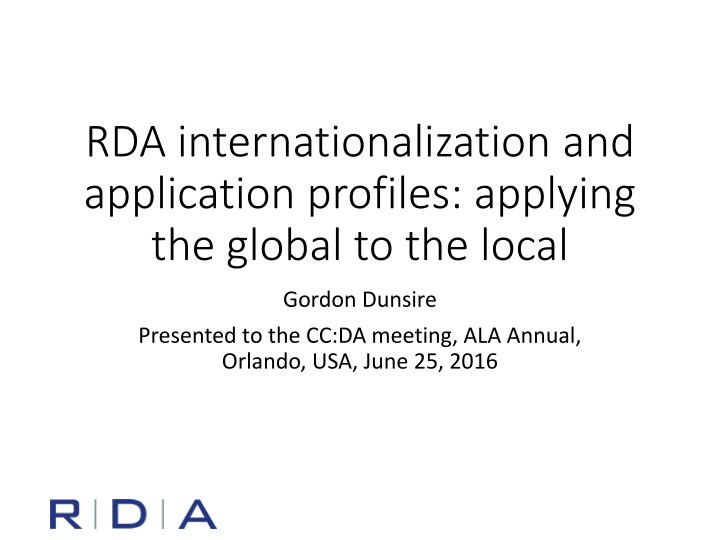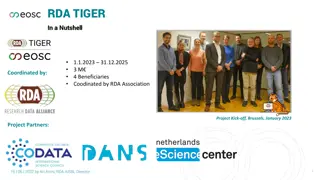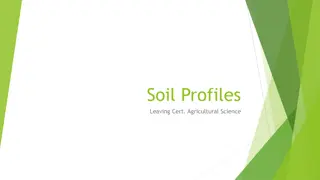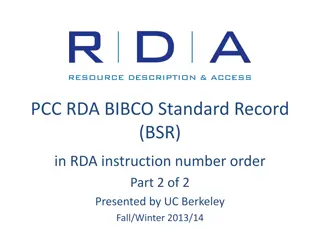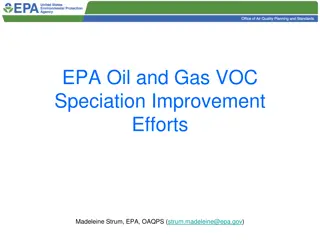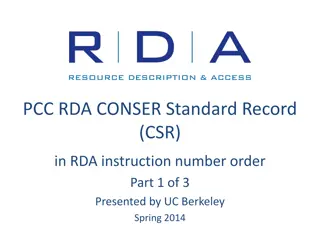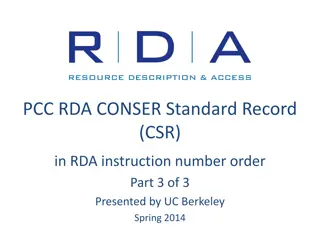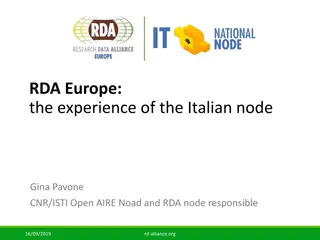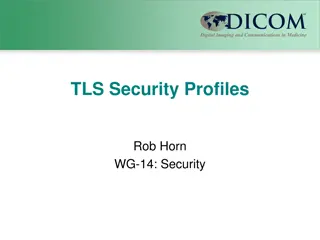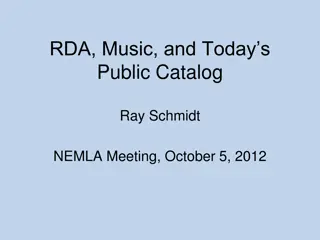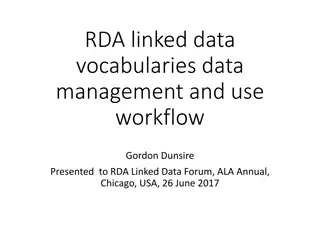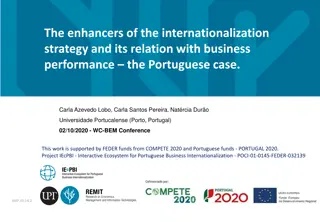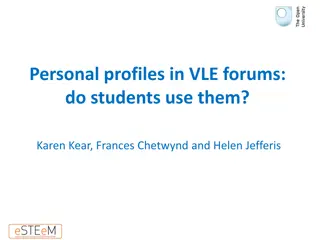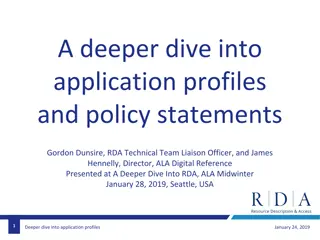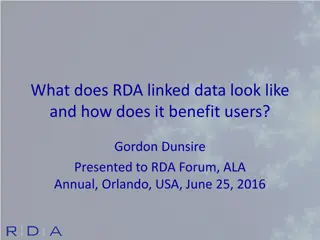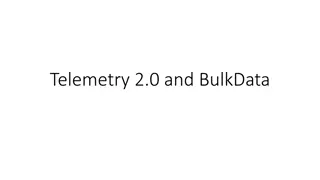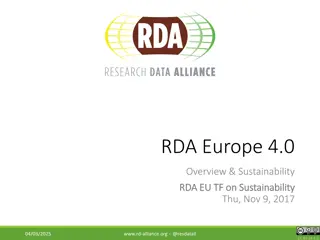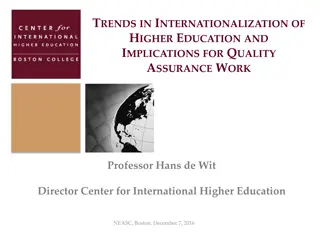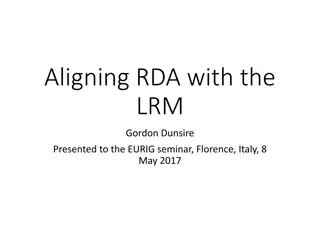RDA Internationalization and Application Profiles
This presentation explores the application of global standards to local contexts, focusing on internationalization developments, application profiles for RDA, local terms and vocabularies, user feedback, and refinements in relationship element types. It discusses governance, user feedback from hackathons, and the refinement of LRM relationships. The presentation also covers attributes, relationships, RDA reference elements, and value vocabularies. It highlights the importance of linked data representations to derive toolkit data and the ongoing review of the RDA Glossary for consistency and completeness.
Uploaded on Apr 08, 2025 | 0 Views
Download Presentation

Please find below an Image/Link to download the presentation.
The content on the website is provided AS IS for your information and personal use only. It may not be sold, licensed, or shared on other websites without obtaining consent from the author.If you encounter any issues during the download, it is possible that the publisher has removed the file from their server.
You are allowed to download the files provided on this website for personal or commercial use, subject to the condition that they are used lawfully. All files are the property of their respective owners.
The content on the website is provided AS IS for your information and personal use only. It may not be sold, licensed, or shared on other websites without obtaining consent from the author.
E N D
Presentation Transcript
RDA internationalization and application profiles: applying the global to the local Gordon Dunsire Presented to the CC:DA meeting, ALA Annual, Orlando, USA, June 25, 2016
Overview Internationalization developments Local choice in global RDA Introduction to application profiles Basic application profiles for RDA Local terms and vocabularies Local refinements
RSC Governance JSC 2015 Edinburgh RSC 2016 Frankfurt CILIP British Library UK Deutsche Nationalbibliothek Europe Now
User feedback Hackathons: Jane-athons Clarity Consistency Simplicity RDA RSC Translation teams
RDA refines LRM relationships as element sub-types (RDF sub-properties) FRBR-LRM and RDA Any Thing: Covers all other types of thing Res has appellation Nomen is created by W E Agent Place is type of M I is associated with Collective agent is modified by Timespan P F C
Refinements Coarse/General is associated with Res1 Res2 has creator has artist Fine/Specific is associated with Res1 Res2 is derivative (E) is adapted as (E) is adapted as graphic novel (E)
Attributes => Relationships has manifestation statement Publication statement Transcribed has place of publication Nomen Place has publisher s name C Nomen M Recorded Timespan Nomen has date of publication
RDA Reference RDA element sets and value vocabularies Linked data representations will be used to derive Toolkit data: Glossary, Relationship designators, and relevant instruction content RDA Glossary in process of review: To improve consistency and completeness To consolidate sub-vocabularies To publish all value vocabularies in OMR Everything in Glossary should be in OMR
RDA Terms Value vocabulary for specialized terms used in instructions, requiring Glossary definitions Possibility of linking to IFLA's Multilingual Dictionary of Cataloguing (25+ languages) Will support extension of RDA to archives and museums communities
RDA policy statements Local choice of variation in general instructions
Local choice of data value vocabulary Local option for vocabularies and terms Vocabulary encoding scheme (VES)
Local choice of data value Aggregated values (e.g. publication statement) Components: place, name, date "date: name (place)"? "place (date : name)"? "place : name, date"? Syntax/string encoding scheme (SES)
Local choice of element Core elements are not mandatory: " a minimum should include " Application profile (AP)
Application profile Specifies each element that is used in an application, how it is aggregated into logical units of information, and if it is: mandatory or optional repeatable associated with a VES associated with an SES or datatype
DC Application profile "a generic construct for designing metadata records that does not require the use of metadata terms defined by DCMI"
Singapore framework RDA + Policy statements RDA Reference FRBR-LRM
Local Application Profile Selects set of RDA elements for the application Identifies locally refined elements for the application Assigns local mandatory and repeatability status to each element Assigns local vocabularies Assigns local syntax encoding and datatypes
Very basic RDA AP: core Expression Element Range Value string String type SES VES Min Max content type non- literal Yes plain RDA Content Type 1 identifier for the expression literal Yes typed [RDA Identifier] (1) language of expression non- literal Yes plain ISO 639-3 scale non- literal Yes typed [RDA Scale] Min: 1 = Mandatory Max: 1 = Non-repeatable
Other basic RDA APs Based on "core for" and "core if" conditions Often focused on a content category E.g. music, cartography, rare materials
Local AP for Expression (example) Element Range Value string String type SES VES Min Max 1 content type non- literal Yes plain Local Content Type 1 1 scale non- literal Yes typed Local Scale Content type uses a local VES, is mandatory, and is non- repeatable Scale uses a local SES (e.g. "1 to 25000"), is mandatory, and is repeatable
Semantic coherency Element/property Unconstrained Domain - Range - Constrained (FRBR) RDA/FRBR entity - Associated VES Local RDA/FRBR entity Entity sub-type VES Local VES Sub-classes Sub-property ladder
4-fold path for relating entities Unstructured description: "The capital city of Scotland" Structured description/access point: "Edinburgh (City of Edinburgh, Scotland)" Strings Identifier: "N 55 57' 7''/W 3 11' 47''" URI: tgn:7009546 Thing
Accommodating the paths Range of a property = type of object in a triple Only two types of object: thing, or string OWL (Web Ontology Language) provides two types of property: ObjectProperty: expects a thing as the object DatatypeProperty: expect a string as the object
4 paths, 2 types Property type Expected object Datatype Literal + SES Literal (typed) + data type Literal (typed) Object URI Path Unstructured Structured Identifier URI
Local vocabularies Vocabulary removed from global RDA becomes a local vocabulary
Local AP for gender Element Range Value string String type SES VES Min Max 1 gender non- literal Yes typed ALA Gender Gender uses a local VES (ALA), is not mandatory, and is non-repeatable
Another gender issue Gender distinctions in roles (relationship designators) have largely disappeared in Anglophone countries: "actor" is gender-neutral But this is not the case in many other languages: "acteur" is male; "actrice" is female Translations make a compromise and use the male form, but this looks strange to metadata users
Local refinements to vocabulary terms RDA actor Person Sub-property Sub-class Local acteur actrice Male Female Range
Conclusion Accommodating the local in the global Accommodating national practice in an international framework Presenting global data in local applications Focusing on the individual in the crowd
Questions? rscchair@rdatoolkit.org RSC website http://www.rda-rsc.org/ RDA Toolkit http://www.rdatoolkit.org/ RDA Registry http://www.rdaregistry.info/ RDA data, Jane-athons, etc. http://www.rballs.info/
